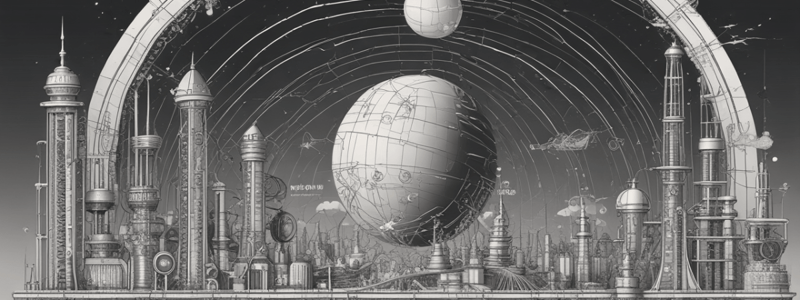Podcast
Questions and Answers
What is the relationship between seconds and minutes?
What is the relationship between seconds and minutes?
- 1 minute is equal to 60 seconds (correct)
- 1 minute is equal to 1000 seconds
- 1 minute is equal to 100 seconds
- 1 minute is equal to 30 seconds
How many seconds are in an hour?
How many seconds are in an hour?
- 3600 seconds (correct)
- 5400 seconds
- 1800 seconds
- 7200 seconds
How many small divisions does the circular dial of a pendulum clock have?
How many small divisions does the circular dial of a pendulum clock have?
- 120 small divisions
- 30 small divisions
- 60 small divisions (correct)
- 90 small divisions
What is the time interval for one oscillation of a pendulum in a pendulum clock?
What is the time interval for one oscillation of a pendulum in a pendulum clock?
Which unit is the largest among the given options?
Which unit is the largest among the given options?
Which device uses the oscillation of a pendulum to measure time?
Which device uses the oscillation of a pendulum to measure time?
How many tiny divisions does the hour's arm move every hour in a pendulum clock?
How many tiny divisions does the hour's arm move every hour in a pendulum clock?
What is the correct value of one year in seconds?
What is the correct value of one year in seconds?
What represents the motion of the second's arm in a pendulum clock?
What represents the motion of the second's arm in a pendulum clock?
How many seconds are there in one day?
How many seconds are there in one day?
Flashcards are hidden until you start studying
Study Notes
Physical Quantities and Measurement
Theme
- Measurement involves a number and a unit to describe a physical quantity.
- Units are universally accepted and used to communicate scientific information without ambiguities.
Physical Quantities
- Four basic physical quantities: length, mass, time, and temperature.
- Each quantity has its own unit and symbol for representation.
Measurement of Length
- Concept of length: distance between two points.
- Units of length:
- Metre (m)
- Submultiples: centimetre (cm), millimetre (mm)
- Multiples: kilometre (km)
- Devices for measuring length:
- Metre ruler
- Measuring tape
- Measurement with a ruler:
- Readings can be affected by parallax error
- Correct reading is obtained when the eye is in front of and in line with the reading
Measurement of Mass
- Concept of mass: quantity of matter contained in a body.
- Unit of mass:
- Kilogram (kg)
- Submultiples: gram (g), milligram (mg)
- Multiples: quintal, metric tonne
- Devices for measuring mass:
- Beam balance
- Electronic balance
- Measurement with a beam balance:
- Standard weights are used
- The total of standard weights gives the mass of the given body
Measurement of Time
- Concept of time: explained in terms of hours, minutes, and seconds.
- Units of time:
- Second (s)
- Minutes (min)
- Hour (h)
Measurement of Temperature
- Concept of temperature: degree of hotness or coldness of a body.
- Unit of temperature:
- Celsius (°C)
- Devices for measuring temperature:
- Clinical thermometer
- Laboratory thermometer
Importance of Measurement
- Measurement is essential in daily life.
- We use instruments or measuring devices to get an exact measurement.
Rules for Units
- Symbols for units are written in small letters.
- Units are never written in plural.
- A space is left between the numerical value and the unit.
- Negative powers are used to express compound units.### Electronic Balance
- The structure of an electronic balance is the load-bearing part that transfers the load of an object to the load cell.
- The load cell converts the load force into electrical signals.
- The signal conditioner is the electronic part that processes the electrical signal and displays the mass.
Measurement of Time
- Time is the interval between two instances or events.
- A solar day is the time taken by the Earth to complete one rotation about its own axis.
- The mean of 365 solar days in a year is called the mean solar day.
Units of Time
- The S.I. unit of time is the second (s), which is defined as 1/86400 part of a mean solar day.
- One second is the time between two consecutive ticks of a pendulum wall clock.
- A minute (min) is a bigger unit of time, with 60 seconds making 1 minute.
- An hour (h) is a still bigger unit of time, with 60 minutes making 1 hour.
- A day is the time taken by the Earth to rotate once on its own axis, which is equal to 24 hours.
- A year is the time taken by the Earth to complete one revolution around the Sun, which is equal to 365 days.
Time Measurement
- A pendulum clock measures time by the time taken for a pendulum to complete one oscillation (2 seconds).
- The clock has a circular dial with 12 markings divided into four quadrants, with 60 small divisions.
- The second's arm moves one small division every second, the minute's arm moves one small division every minute, and the hour's arm moves 5 divisions every hour.
Summary of Time Units
- 1 minute = 60 seconds
- 1 hour = 60 minutes
- 1 day = 24 hours = 24 x 60 x 60 seconds
- 1 year = 365 days = 365 x 24 hours = 3.15 x 10^7 seconds
Studying That Suits You
Use AI to generate personalized quizzes and flashcards to suit your learning preferences.




